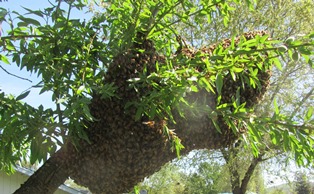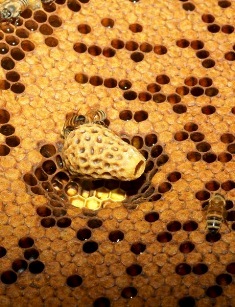Killer Bees Found for the First Time in the East Bay
Global warming might be responsible for our extreme summer heat and the multi-year drought in the Bay Area. It might also explain the presence of killer bees, too. For the first time, U.C. San Diego scientists tracking the Africanized honeybees have found them here in the East Bay city of Lafayette.
The Oakland Tribune suggests the Africanized honeybees are docile unless their hive is threatened. Otherwise, the Africanized or “killer bees” are of similar temperament and have a similar sting as the European honeybees. See, http://www.insidebayarea.com/breaking-news/ci_28892198/killer-bees-detected-lafayette-bay-area-first-time?source=rss
The Africanized bees were bred with European honeybees in Brazil in 1956 to produce a honeybee better suited to Brazil’s climate. The bees escaped their containment, bred with European bees and spread.
The Africanized bees breeding with European honeybees quite possibly means the resulting bees may have a stronger resistance to one of diseases believed responsible for European bee die-offs and colony collapse disorder.
Widely published stories today tell us that the killer bees have been detected in Briones Regional Park in Lafayette, only ten miles from where I keep bees on the Henny Penny Farmette.
Researchers from U. C. San Diego have tracked the bees throughout the state. Likely more than one colony has been established here. But whether or not the bees stay remains to be seen. See, http://www.sfgate.com/bayarea/article/Killer-bees-found-in-the-Bay-Area-for-the-6535892.php
Bees prefer warmer, drier habitats, so they may not stick around. The strong El Nino forecast for this winter could bring much needed rain to the Bay Area and plunging temperatures to the freezing mark.
Africanized bees swarm relentlessly when they perceive a threat. If you are out walking and notice bees foraging on wildflowers, become vigilant. They may not bother you. But do observed them. Don’t swat at them, it will antagonize the bees.
If they start moving toward you, run to at least 100 yards away. Retreat indoors if possible. Don’t think you can escape by jumping into a lake or pool. Researchers say the killer bees have been known to wait above the water.
To read an in-depth analysis of the Africanized honeybee, see http://www.library.ca.gov/crb/99/notes/v6n2.pdf.
To curl up with a cozy mystery that features gentle honeybees, check out my newest novel, A BEELINE TO MURDER: http://www.amazon.com/s/ref=nb_sb_noss?url=search-alias%3Dstripbooks&field-keywords=Meera+Lester&x=0&y=0
Honeybees Have Distinct Personalities
I don’t wear perfume in the garden least the bees think I’m a flower and light on me. But if they do, I let them walk around and explore. I don’t swat at them. Why would I? Honeybees are generally among the most docile of all bees.
Honeybees also have different personality types, according to research published in 2012 in the magazine Science and based on a study by Gene Robinson, University of Illinois entomology professor and director of the Institute for Genomic Biology. See, http://news.illinois.edu/news/12/0308bees_GeneRobinson.html
Scavenging and reconnaissance work carries more risk and challenge, whether you are human or honeybee. An adventuresome personality is usually best suited for that kind of work. Robinson and his researchers observed that the honeybees that do the nest and food scouting express distinct patterns of gene activity in molecular pathways that have been associated with thrill-seeking.
Whereas the adventurous scouts choose the thrill of taking off, the more intrepid and timid bees tend to stick closer to home, doing the tasks of building the hive, cleaning it, caring for the babies, and making honey. Robinson’s research debunks the ages-old idea that the colony’s workers are interchangeable.
America’s first honeybees arrived in from Europe by ship to the American colonies in the 17th century. It took approximately 200 years for the honeybees to get to the West Coast from that early introduction. Some went feral. See, http://www.orsba.org/htdocs/download/Honey%20Bees%20Across%20America.html
The most aggressive honeybee personality is the Africanized bee (aka, killer bees). These bees attack (often in droves) if they perceive a threat to their nest or queen. See, http://www.independent.ie/world-news/americas/couple-attacked-by-swarm-of-30000-bees-who-kill-their-two-horses-29456104.html
The Africanized bees have spread from Brazil, where honeybees from Europe (highly valued for pollinating crops and producing honey) were interbred with bees from Africa. These bees were inadvertently released in the 1950’s in Brazil and began to migrate north. They are now in Texas, New Mexico, Nevada, Arizona, and California. See, http://bees.ucr.edu/ahb-facts.html
All this information about work and personality types as it relates to honeybees makes me wonder: If we humans suited our work to our personality types, would we work as contentedly as do the bees in the garden and those in the hive?
 Facebook
Facebook Goodreads
Goodreads LinkedIn
LinkedIn Meera Lester
Meera Lester Twitter
Twitter






